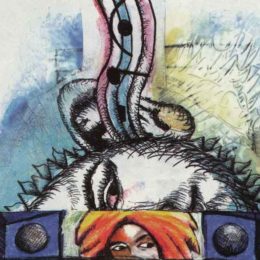“Tooth Pick”, “Groover”, “Fruit-T”, “Tangles”, “Iron Gloves”, “Dog”, “Little Master” may sound like horses lined up to run in the Derby. Instead they are athe nicknames, aliases if you will, of some of the best cricketers the world has ever seen. Discover some of them with a smile.
In his youth Clive Lloyd was known as “Super Cat” because of his brilliant fielding. He was also called “Groover” — perhaps for his dancing — by the Australians, especially their captain, Ian “Chapelli” Chappell. Bad knees, from years of batting, bowling and diving for the ball in Test cricket, have now curtailed the super groove. Wes Hall was known as “The Chief”, perhaps through a premonition that he would eventually become Chairman of Selectors. Someone may also have had a vision of the future and seen that Richard Edwards would become the best ground curator in the Caribbean, for he was called “Prof”. Desmond Haynes, for no apparent reason, was known as “Dubert”, while his constant opening partner, Gordon Greenidge, was called “Two Pooch”, presumably a passing reference to his initial failures in Australia. His form recovered quickly but the name remained. Australia’s Rod Marsh, “Iron Gloves”, also made many batsmen regret their initial feeling about his wicket-keeping ability.
Mike Holding was known as “Mr T”, more for his coolness than the brawn of the American television actor, while his best friend, Andy Roberts, was called “Fruit T”, a reference to the only drink other than water that he would drink. England’s R.G.D. “Bob” Willis was known as “Dillon”, more because he admired the US folk singer, Bob Dylan, than the fact that it was one of his middle names. David “Little D” Murray had to be distinguished from his namesake and team-mate, Deryck Murray, “DL”. At 6’ 9”, 250 pounds of pure bone and muscle and size 16 shoes, Joel Garner was our “Big Bird”. England’s Geoff Arnold, as “Horse”, Colin Croft was known as “Goofy” and Australia’s Max Walker as “Tangles” because of their unusually confused look when bowling. Batsmen did not think the results that funny. Australian Lenny Pascoe was called “Crazy” or “Madman” because of his aggression.
Viv Richards not only treated bowlers with great disdain, but he had the physique of the destructive boxer, hence “Smoking Joe.” If only boxers could hit that hard. In later, balding years, he became “Uncle Smokes”. Lawrence Rowe was known as “Yagga”. Let this not fool you: no-one hit the ball with more finesse and accuracy than “Yaggs”. Lance “Tooth Pick” Gibbs was the opposite of Viv, in physical stature. He was pencil-thin in his playing days. Indian batsman Sunil Gavaskar, at about 5’ 5”, pounded the West Indies bowling so much that he was known as “The Little Master”. God help us if he were any bigger. England’s Deryck Underwood was known as “Deadly”. Most batsmen would confirm that his leg-breaks were. “The Walrus” was claimed by at least three: Australia’s David Boon and Merv Hughes and England’s Graham Gooch. They all had large, pronounced moustaches. Australian Mark Taylor, as “Tubby”, was somewhat so at the start of his career, but no more. The same could not be said of Viv Richard’s close friend, England’s Ian “Beefy” Botham. He was always a big boy.
While some of these names are obvious — “Fowls” for England’s Graeme Fowler, “Macco” for Malcolm Marshall, “Amby” for Curtley Ambrose, “Duje” for Jeff Dujon, “Kingdom” for Collis King, “Lamby” for Clayton Lambert, even “Zed” for Pakistan’s Zaheer Abbas — others are rather perplexing. “Danny Germs” was the nickname for Richard Austin. This man was so gifted — playing soccer, cricket, table tennis and even golf at a very high level — that the name was puzzling. However, the meaning was that you couldn’t get away from him, he was everywhere, like germs. England’s David “Bumble” Lloyd got his name, not because he made a lot of mistakes, but because his character was so effervescent and lively, like the bumble bee.
Phil Simmonds is known as “Pip”, while West Indies captain Brian Lara is sometimes called “Dog” by his Trinidad and Tobago team-mates. Only they could explain these names. Mohinder Armanath of India was named “Jimmy”, a name I still cannot explain. Gus “Rags” Logie could be explained. He was so small that his cricket clothes always seemed to be hanging on his body. Keith Atherton was the opposite. He was sometimes called “Best Dressed” because his clothes fit like gloves.
Roy Fredericks was known as “Kid Cement”, a reference to his hard-headedness in the days when there were no protective helmets for batsmen. Sew Shivnarine, as “Blackjack”, knew nothing about the card game. His skin-tone was simply extra dark. Perhaps the best of these names, though, is the one for Australia’s fast bowler extraordinaire, Dennis Lillee, or “FOT”. These are actually initials to demonstrate his attitude to batsmen, whom he invariably described on the field of play as “F****** Old Tarts.”
Cricketing culture is rich with all sorts of jokes. After all, was it not the venerable commentator, John Arlott, who managed to remark, in 1976, at the Kensington Oval in London; “The bowler’s Holding, the batsman’s Willey”?
















